Visiting a dentist
How often people visit a dentist
In 2013, almost 4 in 5 children aged 5–14 visited a dental practitioner in the previous 12 months (79%), and 9 in 10 visited within the previous 2 years (91%). Just over half (55%) of adults aged 25–44 had visited a dental practitioner in the previous 12 months and 75% had visited in the previous 2 years.
A higher proportion of females visited within the previous year than males (68% and 61%, respectively).
People living in lower income households went to a dental practitioner less often than those in higher income households. More than half of those with a household income of less than $30,000 per year had visited the dental practitioner in the previous year (57%), compared to two-thirds of those with a household income of at least $140,000 (68%). Four out of 5 of the lower income group hadn't visited a dental practitioner at all in the past 2 years (25%), compared to fewer than one-sixth (15%) of the higher income group.
Adults living in Major cities were most likely to have visited a dental practitioner in the previous year (64%). Just over half of those living in Remote/Very remote areas (55%) had visited in the previous year.
Almost three-quarters of those with dental insurance (74%) visited a dental practitioner within the previous year, compared to about half of those uninsured (51%).
Some people are eligible for free or subsidised dental care provided by state and territory governments. There was no significant difference between dentate adults eligible for public dental care and those who were not eligible: 62% of both had visited in the previous year.
The proportion of adults aged 15 and over who made a dental visit in the previous 12 months was higher in 2013 than in 1994 (60% and 56 %). The proportion of children aged 5–14 who made a visit in the previous 12 months was relatively steady, varying from around 78% to around 83% over this time.
Figure 1: Last dental visit was in the previous 12 months, children aged 5–14 and people aged 15 years and over, 1994–2013 (per cent)
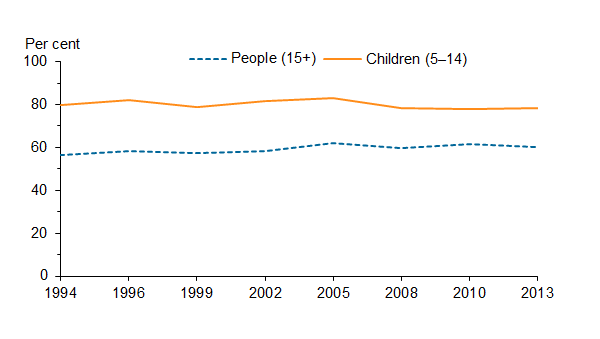
Notes
- Data in this figure relate to dentate persons only.
- Directly age-standardised to the 2001 Australian population.
Source: National Dental Telephone Interview Survey, 1994 to 2013.
In 2010, Australians were more likely to have visited a dental practitioner in the past 12 months than New Zealand residents (2009). However, in 2007–09, Canadians were 30% more likely to have visited than Australians, across all age groups from 20 to 79.
Reasons for visiting a dentist
Younger people were more likely to visit a dentist for a check-up than adults in 2013. About 4 in 5 people aged under 25 reported that their last dental visit was for a check-up (ranging from 76% for those aged 15–24 to 80% for children aged 5–14). In contrast, almost half of adults aged 45–64 attended because of a problem (46%).
With the exception of those in the lowest household income group, visiting for a check-up was more common for people in higher income households. Nearly three-quarters of those with a household income of $140,000 or over had last visited for a check-up (74%). Only half of people in the ‘less than $20,000’ and ‘$20,000–$30,000’ household income groups had done so (48% and 49%).
People living in Major cities had higher rates of visiting for a check-up (65%) than those in Remote/Very remote areas (57%).
More people who had insurance (70%) reported that their last visit was for a check-up than those without insurance (56%).
A smaller proportion of people eligible for public dental care visited for a check-up (55%) than people not eligible (67%).
Australian adults aged 25 to 74 were more likely to have last visited a dental practitioner (2010) for a check-up than their New Zealand (2009) counterparts. Across these age groups, the increased likelihood of visiting for a check-up ranged from 24% to 30%.
Of those who made a dental visit in the previous 12 months the proportion of people aged 15 and over who last visited for a check-up increased from 48.3% in 1994 to 61.4% in 2010. The proportion of children aged 5–14 who visited for a check-up reached a high of 83.1% in 2010.
Figure 2: Last dental visit was for a check-up, children aged 5–14 years and adults aged 15 years and over, 1994–2013 (per cent)
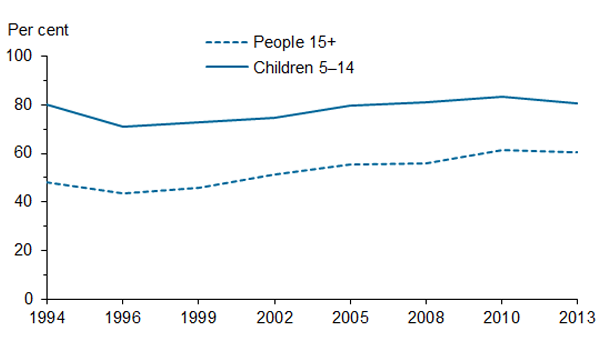
Notes
- Data in this figure relate to dentate adults who made a dental visit in the previous 12 months.
- Directly age-standardised to the 2001 Australian population.
Types of dental practice visited
In 2013, around 8 in 10 (84%) people reported that their last dental visit was to a private dental practice, compared with about 1 in 10 to a public dental service (9%) and 1 in 20 to a school dental service (4%).
Just under one-quarter of children aged 5–14 (21%) attended a school dental service for their last dental visit and nearly two-thirds (64%) attended a private practice.
A higher proportion of people from lower income households (up to$30,000) used a public dental service than those on higher incomes. Over a quarter of dentate people in the ‘less than $20,000’ and ‘$20,000 to $30,000’ household income brackets (29 and 31%) visited a public dental service at their last visit. This compares to 2% of those with a household income of $100,000 and over. Use of school dental services was relatively even across all income groups.
Across remoteness areas, use of a school dental service was highest in Remote/Very remote areas (24%) and lowest in Major cities (8.3%). The use of public dental services was lowest in Major cities (3%) and highest in Outer regional areas (8%).
The proportion of adults who visited a private dental practice remained stable 1994 to 2013 at around 88%.
A higher proportion of insured people accessed private care at their last visit than uninsured people (93% and 71% respectively).
Around 7 in 10 people eligible for public dental care (70%) and nearly 9 in 10 not eligible (89%) accessed private care at their last visit.
The proportion of children aged 5–14 who visited a public dental service remained low (less than 10%) from 1994 to 2010 and increased to 14% in 2013. From 2002, the proportion who visited a private practice increased, with a complementary decrease in those visiting a school dental service.
Figure 3: Type of practice visited at last dental visit, children aged 5–14 years, 1994–2013 (per cent)
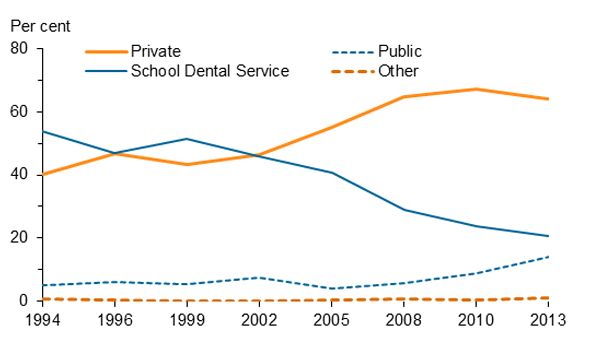
- School dental service (SDS) describes the school or community dental service operated by the health department or authority in each Australian state and territory. Children from both public and private schools are eligible for dental care through an SDS.
- Other includes: armed forces dental service, clinics operated by private health insurance companies, dental technicians and other (not elsewhere classified).
Notes
- Data in this figure relate to dentate children aged 5–14 years who made a dental visit in the previous 12 months.
- Directly age-standardised to the 2001 Australian population.
Source: National Dental Telephone Interview Survey, 1994 to2013.
Patterns in dental visits
A favourable dental visiting pattern is where regular visits (1 or more in 12 months) are made to a dentist, for the purpose of a check-up and having a usual dental provider who is familiar with the patient's oral health history. An unfavourable visiting pattern is where irregular dental visits are made, usually for a dental problem and without having a regular dental provider.
Overall in 2013, almost half of all dentate adults (44%) had favourable dental visiting patterns.
Dentate adults aged 65 had similar rates of favourable attendance as those aged 25–44, and 18-24 (48%, 48% and 49%, respectively). Higher rates of unfavourable attendance were reported for 25–44 year olds than 18–24 year olds (27% and 15%, respectively).
A higher proportion of women had favourable visiting patterns (50%) than men (38%).
Visiting patterns of dentate adults varied by household income. Under one-third of adults in the lowest income group (27%) had favourable visiting patterns, compared to over half of those in the highest group (57%).
Dentate adults who lived in Major cities had higher rates of favourable attendance (47%) than those in Remote/Very remote areas (31%).
Almost two-thirds of dentate adults who were insured (61%) had favourable visiting patterns, compared to under one-third (27%) of those without dental insurance. Just over one-third of adult people eligible for public dental care had favourable visiting patterns (35%), compared to almost one-half of those not eligible (47%).
The proportion of adults with a favourable visiting pattern increased from 36% in 1999 to 44% in2013, though there was a decrease from 46% in 2010.
Figure 4: Dental visiting patterns, dentate people aged 15 years and over, 1999–2013 (per cent)
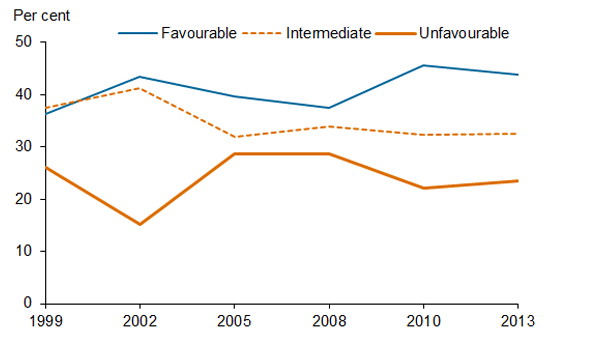
Notes
- Data in this figure relate to dentate people aged 15 years and over.
- Directly age-standardised to the 2001 Australian population.
Source: National Dental Telephone Interview Survey, 1994 to 2013.
Services at the dentist
In 2013, dentate people aged 5+ years who visited a dental practitioner in the last 12 months made, on average, 2.4 visits. On average each person had a scale and clean, 2 in 3 people had a filling, and 1 in 4 had an extraction.
People in the two highest income groups (‘$90,000 to less than $140,000’ and ‘$140,000 plus’) had on average fewer extractions and fewer fillings than those in the lowest income group (‘less than $30,000’). Those in the ‘$30,000 or less’ income group and the $60,000 to less than $90,000 group had fewer scale and cleans than individuals in the highest income group.
People in Major cities made on average more dental visits than people in Outer regional and Remote/Very remote areas. They also had more scale and cleans than those of Inner and Outer regional areas.
There was no significant difference in the number of visits, number of extractions, or fillings between people with and without dental insurance. However, people with insurance had a higher number of scale and cleans.
There was no significant difference in overall number of visits between adults eligible for public dental care and those not eligible. Adults eligible for public dental care had more extractions and fillings, and fewer scale and cleans, than adults not eligible.
Between 1994 and 2013, for adults who visited the dentist in the past 12 months, the average number of visits varied between 2.3 and 2.4. There was a decline in the average number of fillings received (0.9 to 0.7). There was an overall increase in the average number of scale and clean services received, from 0.97 to 1.12 over the entire period. The average number of extractions fluctuated over the period, ranging from 0.21 in 1994 to 0.32 in 1999 and 2002.
Figure 5: Types of services received by people aged 15 and over, 1994-2013 (average)
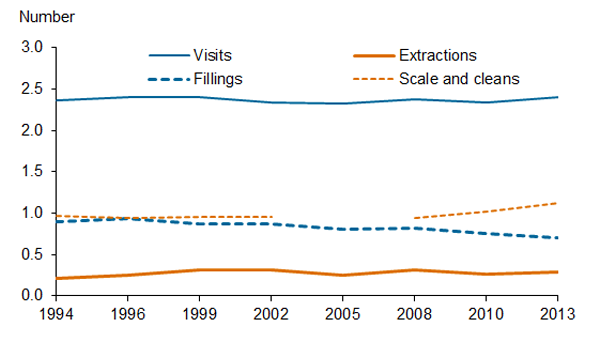
- Data on number of scale and clean treatments received were not collected in 2005.
Notes
- Data in this figure relate to dentate people aged 15 years and over who made a dental visit in the previous 12 months.
- Directly age-standardised to the 2001 Australian population.
Source: National Dental Telephone Interview Survey, 1994 to 2013.
Between 1994 and 2010, the average number of visits for children remained stable, between 2.1 and 2.4 visits. There were no clear changes in service types (extractions, fillings and fluoride treatment) over the period.
Figure 6: Types of services received by children, 1994-2013 (average)
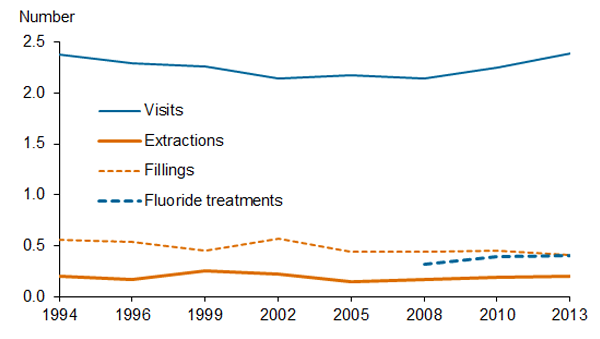
Notes
- Data on fluoride treatments received were not collected prior to 2008.
- Data in this figure relate to children aged 5 to 14 years who made a dental visit in the previous 12 months.
- Directly age-standardised to the 2001 Australian population.
Source: National Dental Telephone Interview Survey, 1994 to 2013.
Preventing tooth decay in children
A common and effective way to stop the development of active tooth decay in permanent teeth is fissure sealing. A resin or glass-ionomer (cement) material is applied to fill the pits and grooves of permanent teeth (usually molars), sealing them to prevent build-up of bacteria and plaque.
Dental examinations in 2010 (in states and territories other than New South Wales and Victoria) showed children aged 5–14 with some decay in their permanent teeth were more likely to have a fissure sealant than children of the same ages who had no decay. Overall, this indicates that children with higher risk of decay were more likely to receive fissure sealants.
Figure 7: Teeth with fissure sealants, Australian children aged 12, 1989–2010 (average)
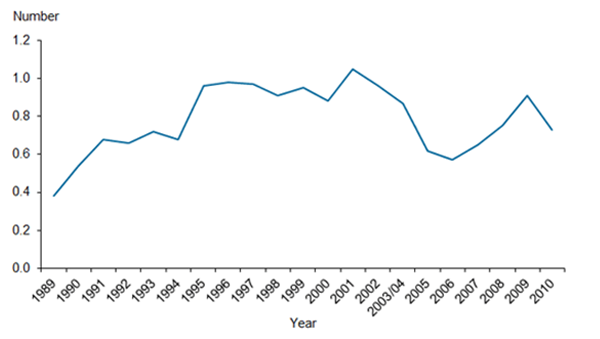
Source: Child Dental Health Survey, 1989 to 2010.
The average number of fissure-sealed teeth among children aged 12 fluctuated around 0.8 teeth throughout the period.


